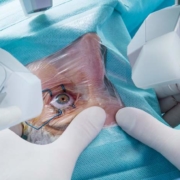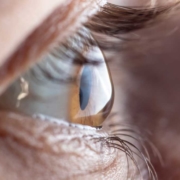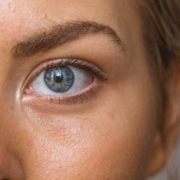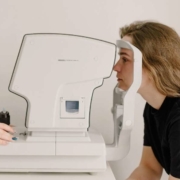Hyperopia: Everything You Need to Know about Farsightedness
By Dr. Anthony Nappi / Published August 19, 2022 / 3 min. read

Have you ever wondered why you can see the moon clearly but can’t read the sign right before you? If so, you may have a common vision condition known as hyperopia.
Commonly known as farsightedness, hyperopia denotes a type of refractive error that affects millions of people around the world. If you have this condition, your eyes cannot focus on close objects as clearly as they should. This can make close-up tasks like reading and knitting difficult.
The following blog will teach you about far-sightedness, treatment, and how to live with it. Read on.
How Does Farsightedness Occur?
Farsightedness occurs when the eyeball is too short or the cornea’s (the eye’s clear front surface) curve is compromised. Because of the bad shape, the light rays don’t focus on the retina (the light-sensitive layer of tissue at the back of the eye).
Refractive error also occurs when the light focuses behind the retina but not on it. In this case, the beams travel to the back of the retina before the lens and cornea have properly bent them. Either way, these changes cause distant objects to appear blurred.
Light refracts through an uneven, rough lens or cornea, exacerbating other refractive errors, including myopia, hyperopia, and astigmatism.
What are the Symptoms of Farsightedness?
If you’re farsighted, your eyes must work hard to see anything up close, causing eyestrain. This is the main symptom. However, most don’t realize what’s happening until other symptoms kick in.
These include:
- Blurry vision for words or objects up close
- Squinting to see better
- Aching farsightedness
- General eye discomfort
You may experience a headache after completing tasks that require close-up concentration. This may include drawing or reading.
Also, strabismus (crossed eyes) can develop in children when significant farsightedness is not diagnosed and corrected.
What are the Causes of Hyperopia?
As aforementioned, farsightedness is caused by improper light refraction in the eyes. Farsightedness may also be inherited. People born with this condition can focus on distant objects during childhood. However, it may become more difficult to focus as time passes and even foreign objects may become obscured. Farsightedness can be caused by:
- Diabetes
- Tumors
- Fovea hypoplasia, also known as macular hypoplasia, is a rare medical condition characterized by the macula’s underdevelopment
How is farsightedness Diagnosed and Tested?
Your optometrist or ophthalmologist will perform a comprehensive eye examination to diagnose farsightedness. They will use a standard vision test to determine if you have hyperopia, in which you will be asked to read letters on a chart at the opposite end of the room.
If the vision test reveals that you are farsighted, your doctor will use special equipment and techniques to determine what might be causing your hyperopia.
Eye Dilation
Dilating your pupils with eye drops may sound like a medieval torture method, but it’s a routine part of many eye exams. Besides, it’s a painless procedure, but you may experience discomfort.
The active ingredient in most pupil-dilating drops is called cyclopentolate, and it works by temporarily paralyzing the muscles that control your pupil size. That’s why your eyes may dilate for several hours after your exam. If you’re planning on going out on a date or doing anything else that requires a clear vision, you might want to schedule your eye exam for another time.
Phoropter
A phoropter is a machine used to measure the severity of a person’s refractive error or the amount of correction needed to achieve 20/20 vision. The phoropter looks like a large mask with multiple camera lenses and is held in front of the patient’s eyes during the exam. The provider will then use the phoropter to determine the best corrective lens prescription for the patient.
Retinoscope
A retinoscope is used by competent ophthalmologists and optometrists to assess someone’s vision. It aids them in determining whether a person is farsighted or nearsighted. The retinoscope also checks for astigmatism, which occurs when the eye does not focus light evenly on the retina. (Part responsible for image processing and transmission to the brain.)
To use a retinoscope, the doctor will instruct you to look at a distant object, such as a wall clock. As a result, they will move the retinoscope back and forth while shining the light into your eye. The doctor will look for changes in your eyes as the light reflects off your retina as the light moves. If you are farsighted, the light will reflect off your retina before reaching the center of your eye.
This procedure is not appropriate for pediatric patients.
Management and Treatment
The primary objective of hyperopia treatment is to help direct light on the retina. This can be achieved by using prescription lenses or refractive surgery.
Prescription Lenses
Depending on your degree of farsightedness, prescription lenses may be required to improve your near vision. This is especially likely as you get older and your eye lenses become less flexible. Farsightedness is treated by wearing prescription lenses. It helps compensate for the compromised curvature in your cornea.
There are two types of prescription lenses:
Contact Lenses
Contact lenses are essentially sunglasses but way smaller and concealed. They sit directly on the surface of the eyeball. All in all, they correct the way light bends. They are generally safer, more comfortable, and more convenient. However, you may encounter issues that prevent you from wearing them. These difficulties include dry eyes, allergies, and recurring eye infections.
Eyeglasses
If contact lenses aren’t the right option for you, your doctor may prescribe eyeglasses. Eyeglasses for this condition come with lenses that provide a simple way of altering how light focuses on your retina. The type of lenses you need and how frequently you should wear them will be determined by how farsighted you are.
Refractive Surgery
Although most refractive surgical procedures are used by optometrists in Metro Phoenix, Arizona, to treat nearsightedness, they can also be used to treat farsightedness. These surgical treatments correct farsightedness by reshaping the curvature of your cornea. Methods for refractive surgery include:
Laser-Assisted in Situ Keratomileuses (LASIK)
To improve vision, your eye doctor will use a cutting laser to correct the shape of the cornea (dome-shaped clear tissue at the front of your eye) during LASIK vision correction surgery.
Photorefractive Keratectomy
A laser is used in this type of surgery to treat vision problems caused by refractive errors. Your ophthalmologist will use a laser to change the shape of your cornea during PRK. This improves the focus of light rays on the retina.
Laser-assisted subepithelial keratectomy (LASEK)
It is a “hybrid” procedure that combines LASIK and photorefractive keratectomy (PRK). The LASEK technique, like PRK, aims to reduce the occurrence of flap-related complications associated with LASIK. It is especially useful in patients with corneas that are otherwise too thin for LASIK. By retaining a flap of corneal epithelium, LASEK may reduce the risk of infection and the incidence of corneal haze compared to PRK.
How to Prevent Farsightedness?
If you’re worried about developing farsightedness, you don’t need to fret – it’s not something you can prevent. However, there are things that you can do to take care of your eyes and keep them healthy.
- Eat a healthy diet
- Wear protective eye gear when it’s too sunny or dusty
- Get regular eye exams to help catch any problems early on
- See your doctor yearly if you have an increased risk of getting chronic conditions that could affect your vision, like high blood pressure or diabetes
- If you already have ongoing eye problems, it’s important to follow your doctor’s treatment plan
- In case you develop any changes in vision or experience eye pain, redness, or discharge, be sure to see a qualified medical professional immediately
These simple steps can help keep your eyes healthy and avoid any potential problems down the road.
Farsightedness Outlook/Prognosis
The question in most people’s minds is whether farsightedness goes away or gets worse. The answer is yes and no.
Even after treatment, farsightedness doesn’t go away completely; it may return after several years. However, glasses and contact lenses are the most common form of treatment. With these, you’ll see clearly both near and far. Your vision may change over time, and you may need stronger glasses or contacts as you age.
If you have farsightedness, it’s important to have regular eye exams so your doctor can monitor your condition and ensure your treatment is working. You should also be aware of any changes in your vision and see your doctor if you develop any new symptoms. With proper care, you can keep your farsightedness under control.
Living with Farsightedness
If you’re farsighted, you’re not alone – it’s a common condition. In fact, according to the National Eye Institute, about 30 percent of Americans are proactive. And while it’s most common in kids and young adults, it can happen at any age.
So, what can you do if you’re one of the many people dealing with this vision problem? Well, there are a few different options:
First, having a regular eye exam is important to ensure that your prescription is up to date
Also, take breaks when working or reading for long periods and position yourself so that light is coming from behind you.
If you are squinting, you may also want to consider wearing glasses or contact lenses.
Finally, remember that farsightedness tends to worsen over time, meaning that it’s important to visit an eye doctor in Metro Phoenix, AZ, regularly to monitor your vision, and adjusting as needed is important
Ask about order

 iStock
iStock iStock
iStock
 iStock
iStock

 iStock Photography
iStock Photography
 iStock
iStock